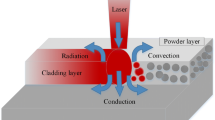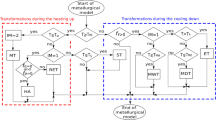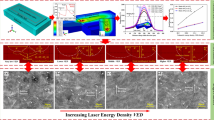Abstract
Laser-based phase transformation hardening (LPTH), based on rapid heating and cooling cycles produces hard and wear-resistant layers only at the selective region of the components. However, the bulk mass of the material’s core property is retained. The advantages of high power direct diode laser in comparison with other high power lasers (CO2 and Nd:YAG) have put this type of laser as a main heat source for localized heat treatment. However, a tempered zone is formed in overlapping regions of a large heat-treated area during multi-pass laser heat treatment (MPLHT) that affects the uniformity of heat-treated depth of material. This study is focused on the development of a uniform hardness distribution model to minimize the tempering effect during the MPLHT process. A tool steel AISI S7 is heat treated by using different levels of laser power (1,400–1,800 W) and scanning speeds (15–25 mm/s). An experimentally based finite element (FE) thermal model is developed to predict the cross-sectional as well as surface temperature history of the MPLHT process. The temperature-dependent material properties and phase change kinetics are taken into account in the model. The laser beam is considered as a moving rectangular-shaped heat source (12 mm × 1 mm) with a uniform distribution (top-hat) of laser power. The temperature history acquired from the FE thermal model is coupled with thermo-kinetic (TK) equations to determine the corresponding phase transformations and hardness. The tempering effect of MPLHT is studied for different sizes of overlap (1 mm–3 mm) and lengths of scan (10 mm–35 mm). The TK model results are verified with experimental ones to optimize the processing parameters. The optimized processing parameters, including laser power, scanning speed, size of overlap, and the length of scan are used to achieve a uniform hardness distribution and an even depth of heat treatment in the MPLHT area.
Similar content being viewed by others
References
Kathy Kinkade (2006) Diode lasers test their mettle in surface treatment, Laser Focus World: 95–97
Safdar S, Li L, Sheikh MA, Liu Z (2006) An analysis of the effect of laser beam geometry on laser transformation hardening. J Manuf Sci Eng 128:659–667
Haake JM, Zediker MS (2004) High power direct diode laser successes. SPIE 5336:107–115
Kennedy E, Byrne G, Collins DN (2004) A review of the use of high power diode lasers in surface hardening. J Mater Process Technol 155–156:1885–1860
Bohler Uddeholm United States (2009) Uddholm Ramax, LH, Stainless Mold Base Steel, www.bucorp.com, Accessed November 2009
Foroozmehr E, Kovacevic R (2009) Thermokinetic modeling of phase transformation in the laser powder deposition process. Metall and Mat Trans A 40A:1935–1943
Costa L, Vilar R, Reti T, Deus AM (2005) Rapid tooling by laser powder deposition: process simulation using finite element analysis. Acta Mater 53:3987–3999
Totten GE, Steel heat treatment handbook: metallurgy and technologies (2006) CRC Taylor & Francis.
Lakhar RS, Shin YC, Krane MHM (2008) Predictive modeling of multi-track laser hardening of AISI 4140 steel. Mater Sci Eng, A 480:209–217
Yao C, Xu B, Huang J, Zhang P, Wu Y (2010) Study on the softening in overlapping zone by laser-overlapping scanning surface hardening for carbon and alloyed steel. Opt Laser Eng 48:20–26
Tani G, Orazi L, Fortunato A, Campana G, Ascari A, Cuccolini G (2008) Optimization strategies of laser hardening of hypo-eutectoid steel, The 41st CIRP Conference on Manufacturing Systems: 355–360.
Zhang Z, Delagnes D, Bernhart G (2004) Microstructure evolution of hot-work tool steels during tempering and definition of a kinetic law based on hardness measurements. Mater Sci Eng A 380:222–230
Tian Y, Shin YC (2006) Thermal modeling for laser-assisted machining of silicon nitride ceramics with complex features. J Manuf Sci Eng 128:425–434
Skvarenina S, Shin YC (2006) Predictive modeling and experimental results for laser hardening of AISI 1536 steel with complex geometric features by a high power diode laser. Surf Coat Technol 201:2256–2269
Fortunato A, Orazi L, Tani G (2009) A new computationally efficient model for tempering in multi-tracks laser hardening, Proceedings of the ASME 2009 International Manufacturing Science and Engineering Conference (MSEC 2009) Paper #MSEC2009-84093
Campana G, Ascari A, Tani G (2009) A method for laser heat treatment efficiency evaluation in multi-track surface hardening, Proceedings of the ASME 2009 International Manufacturing Science and Engineering Conference (MSEC 2009) Paper #MSEC2009-84095
Bailey NS, Shin YC (2009) Optimization of laser hardening processes for industrial parts with complex geometry via predictive modeling, Proceedings of the ASME 2009 International Manufacturing Science and Engineering Conference (MSEC 2009) Paper #MSEC2009-84012
Rana J, Goswami GL, Jha SK, Mishra PK, Prasad BVSSS (2007) Experimental studies on the microstructure and hardness of laser-treated steel specimens. Opt Laser Technol 39:385–393
Capello E, Previtali B (2008) Optimization of production rate in diode laser hardening. J Laser Appl 20:1–11
ANSYS® 11.0 (2009) Manually accessed on November 2009
Capello E, Castelnuovo M, Previtali B, Vedani M (2007) Surface treatment of welded duplex stainless steels by diode laser. J Laser Appl 19:133–140
Woo HG, Cho HS (1999) Three-dimensional temperature distribution in laser surface hardening processes. IMechE Proc Inst Mech Eng B 213:695–712
Kasatkin OG, Vinokur BB, Pilyushenko VL (1984) Calculation models for determining the critical points of steel. Metal Sci Heat Treat 26:27–31
Steven W, Haynes AG (1956) The temperature of formation of martensite and bainite in low alloy steels. J Iron Steel Inst 183:349–359
Kung CY, Rayment JJ (1982) An examination of the validity of existing empirical formulae for the calculation of M S temperature. Metall Trans A 13A:328–331
Hojerslev C (2001) Tool steels. Riso National Laboratory, Roskilde
Kirkaldy JS, Venugopalan D (1983) In: Marder DAR, Goldstein JI (eds) Phase transformations in ferrous alloys. AIME, New York, pp 128–148
Li MV, Niebuir DV, Meekiho LL, Atteridge DG (1998) A computational model for the prediction of steel hardenability. Metall and Materi Trans B: 661–672
Koistinen DP, Marburger RE (1959) A general equation prescribing the extent of the austenite–martensite transformation in pure iron-carbon alloys and carbon steels. Acta Metall 7:59–60
Maynier P, Dollet J, Bastien P (1978) In: Doane DV, Kirkaldy JS (eds) Hardeniability concepts with applications to steels. AIME, New York, pp 163–176
Santhanakrishnan S, Kong F, Kovacevic R (2009) A three-dimensional transient modeling and experimental analysis of laser transformation hardening by using high power direct diode laser, Proceedings of the ASME 2009 International Manufacturing Science and Engineering Conference (MSEC 2009) Paper #MSEC2009-84152
Author information
Authors and Affiliations
Corresponding author
Rights and permissions
About this article
Cite this article
Santhanakrishnan, S., Kong, F. & Kovacevic, R. An experimentally based thermo-kinetic phase transformation model for multi-pass laser heat treatment by using high power direct diode laser. Int J Adv Manuf Technol 64, 219–238 (2013). https://doi.org/10.1007/s00170-012-4029-z
Received:
Accepted:
Published:
Issue Date:
DOI: https://doi.org/10.1007/s00170-012-4029-z




